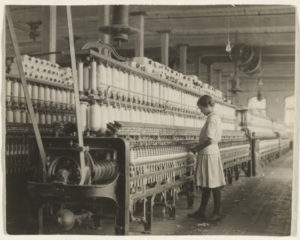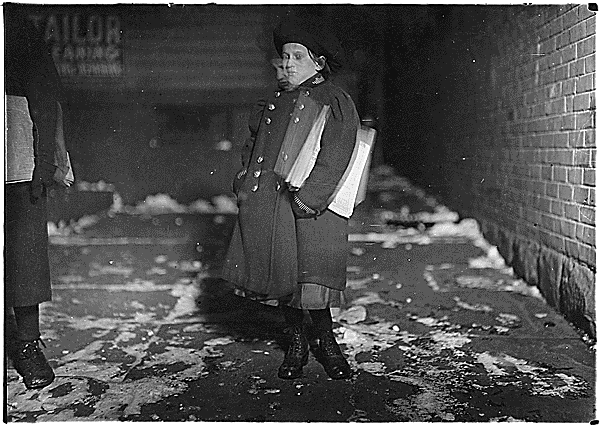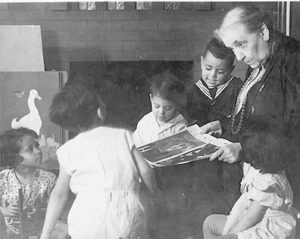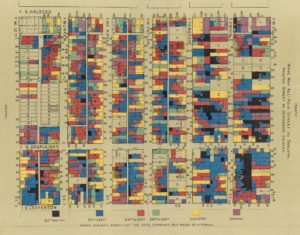The topic of this exhibit is child labor and the right to childhood. Our topic took place primarily in Chicago, Illinois. We chose to focus on this region because it was the region Jane Addams resided in from 1889 to the early 1900s when she was involved in the fight against child labor, immigration reform, peace activism, and women’s suffrage. This exhibit will focus specifically on the Chicago child labor activities of Jane Addams, since it would be too large in scale to cover national child labor activity. Additionally, the exhibit will identify some of the major labor groups and child labor laws that may or may not have been from Chicago, because of either Jane Addams role in them or for additional context.

From Agriculture to Industry
This website is primarily concerned with the time period between the Progressive era of the late 1800s and first World War. Briefly, it is important to understand some of the history prior to the Progressive Era to further emphasize the lack of child labor protection in place, and rather how this concern was so unprecedented prior to the Industrial Age. Before the growth and dependence of an industrialized economy, agriculture and trading were the main economic engine. Elite Southern farmers were dependent on the labor of enslaved African Americans and for smaller rural farms it was a family business. The Industrial Age changed this dependency on crop output to a reliance on wage. Additionally, since the nation’s founding there have been immigrants, but with industrialism, how they have been exploited has changed. Child labor developed in full force during the American Industrial Revolution. Industrialization attracted and often required many workers and their families to move from farms and rural areas into urban spaces and factory work. In factories and mines children were often preferred as employees, because owners viewed them as more manageable, cheaper, and less likely to strike.

The New Child Laborer
Children provided an endless supply of exploitable and disposable labor for factories and businesses. Additionally many immigrant families were dependent on every member of the family contributing to the household income. School therefore was less of a concern then earning enough money to put food on the table. Considering these circumstances, Child labor activists not only had to contend with corporations but also working to convince the parents of children to send their kids to school.

The Role of Women
There were men and women fighting against child labor, but what rendered this subject especially important for women was there ability to step beyond the home. Drawing on maternalism, they could argue that as women, society assigned them to be the “moral” guiders and nurturers, therefore women had a right to work beyond the home in the fight of preserving the home and the child.
The anti-child labor movement was a direct extension of the Progressive Era and other social movements of the time. Other major movements happening during this Progressive Era included Frances Willard’s Temperance movement organized under Woman’s Christian Temperance Movement. This movement again followed the idea that as women they had a moral obligation to be the caregivers of society. The saloon was the public sphere, men’s sphere, but when those men came home drunk it then affected the women’s sphere, the home. Another major movement of the era was the women’s suffrage campaign led by key figures including Susan B. Anthony and Elizabeth Cady Stanton. The memberships of many of these women often overlapped into other organizations and women’s clubs, illustrating the agency of this complex network of women. It is important to note, however, that within these movements racism persisted, undermining a more united effort for all women. Many of these women’s groups or organizations only admitted a specific type of women, often those that had the time, money and status- white, middle to elite class women.
The Right to Childhood
The exhibits topic of interest cannot be compacted within just the few decades consisting of the Progressive era. The importance of childhood is a value that transcends across history and something to explore through this exhibit. In Chicago, newsboys were being poorly treated and so began one of Jane Addams many projects where she decided her help needed to be. The working conditions and experiences of these children included sexual abuse, fourteen hour work weeks, and the expectation to work in any type of weather. Child actors served as another profitable scheme by theaters. Child actors still exist today but what about these children of the nineteenth and early twentieth century render their experience different from the child actors a century later? The exhibit endeavors to connect this past with the future because it remains a relevant and relatable dialogue for understanding why we hold our childhoods to such an importance, a reality that people several decades ago could not fathom.

Jane Addams’s Hull House
A regional aspect the exhibit would like to explore is the Hull House neighborhood. Thanks to the work of Florence Kelley, Jane Addams, and other Hull House residents the exhibit will be able to utilize the Hull-House Maps and Papers for a deeper analysis of a portion of the Chicago neighborhood. The method in which these women were mapping this predominantly immigrant neighborhood by income and nationality provides considerable insight. The maps constructed through their research was a relatively new technique, and their subjects, poor immigrant households, were particularly unique. This map would be less useful probably if it was of a more elitist, upper class demographic, since they could more easily afford for their children to attend school. Not only would the exhibit like to compare these maps of the nineteenth century to the Google maps of today’s Hull House neighborhood, but also touch upon the wages of each household. The Hull House Maps and Papers offers two maps, one plotting the household income of each home and the other color coding the buildings by nationality. The income map provides a visual analysis in which to compare how much of that income could have been earned by a child. In researching the average income of a newsboy or girl, child actor, child factory worker, etc., we can then compare this to the household incomes from the income map.